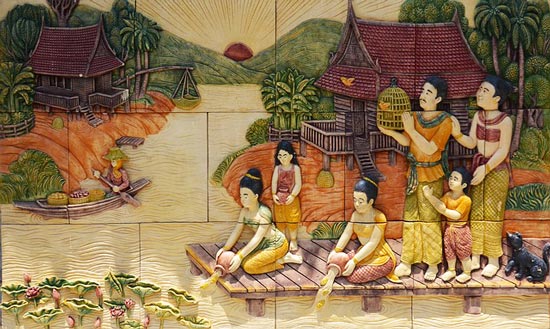History of Thailand
Ancient times and starting points
Principal article: Ancient Thailand
See too: History of Thailand and Tai people groups
There is proof of constant human home in present-day Thailand from quite a while back to the present day.[26]: 4 The earliest proof of rice developing is dated at 2,000 BCE.[27]: 4 Regions containing what is currently Thailand taken part in the Oceanic Jade Street, as learned by archeological exploration. The exchanging network existed for a long time, between 2000 BCE to 1000 CE.[28][29][30][31] Bronze seemed c. 1,250-1,000 BCE.[27]: 4 The site of Boycott Chiang in upper east Thailand at present positions as the earliest known focal point of copper and bronze creation in Southeast Asia.[32] Iron showed up around 500 BCE.[27]: 5 The Realm of Funan was the first and most impressive Southeast Asian realm at that point (second century BCE).[26]: 5 The Mon public laid out the territories of Dvaravati and Realm of Hariphunchai in the sixth 100 years.
The Khmer public laid out the Khmer domain, focused in Angkor, in the ninth century.[26]: 7 Tambralinga, a Malay state controlling exchange through the Malacca Waterway, rose in the tenth century.[26]: 5 The Indochina promontory was vigorously impacted by the way of life and religions of India from the hour of the Realm of Funan to that of the Khmer Empire.[33]
The Thai public are of the Tai ethnic gathering, portrayed by normal phonetic roots.[34]: 2 Chinese accounts first notice the Tai people groups in the sixth century BCE. While there are numerous suppositions in regards to the beginning of Tai people groups, David K. Wyatt, a history specialist of Thailand, contended that their precursors who at present possess Laos, Thailand, Myanmar, India, and China came from the Điện Biên Phủ region between the fifth and the eighth century.[34]: 6 Thai individuals started relocating into present-day Thailand continuously from the sixth to eleventh hundred years, which Mon and Khmer individuals involved at the time.
[35] Subsequently Thai culture was impacted by Indian, Mon, and Khmer cultures.[36]: 203 Tai individuals intermixed with different ethnic and social gatherings in the locale, bringing about many gatherings of present-day Thai people.[h] Hereditary confirmations proposed that ethnolinguistics couldn't precisely foresee the beginnings of the Thais.[37][38][39] Sujit Wongthes contended that Thai isn't a race or nationality yet a culture group.[40]
As per French antiquarian George Cœdès, "The Thai initially enter history of Farther India in the 11th hundred years with the notice of Syam slaves or detainees of battle in Champa epigraphy", and "in the twelfth hundred years, the bas-reliefs of Angkor Wat" where "a gathering of heroes" are depicted as Syam,[15]: 190-191, 194-195 however Cham accounts don't show the starting points of Syam or what ethnic gathering they had a place to.[41] The beginnings and identity of the Syam stay muddled, with some writing recommending that Syam alludes to the Shan public, the Bru public, or the Brau people.[41][42] Nonetheless, central area Southeast Asian sources from before the fourteenth century principally involved the word Syam as an ethnonym, alluding to the people who had a place with a different social class not quite the same as the Khmer, Cham, Bagan, or Mon. This differentiations with the Chinese sources, where Xian was utilized as a toponym.


